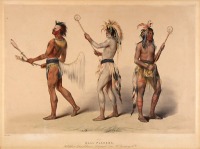
The big buzz in the gaming industry these days is the addition of “social games” to a casino’s marketing arsenal. You know, the “Candy Crush” or free-play kinds of games that you can play on Facebook at no cost (or for a minimal purchase of “chips”). Wins in these games can be parlayed into free buffets, discounted hotel rooms or entertainment tickets, while giving the casinos free publicity and the ability to reach their customers online at any time.
For tribal gaming, however, “social games” have a much different meaning. Social games are defined by the Indian Gaming Regulatory Act as Class I gaming—traditional games that have been played for generations among tribes. Class I games are not subject to any regulatory oversight, either from a tribal gaming commission, the state or the federal government, as opposed to Class II and Class III gaming, both which fall under some form of governmental regulatory review.
But what exactly are Class I games? In his excellent study of traditional Indian gaming in Southern California, San Diego State American Indian Studies Professor Richard L. Carrico says the extent of these games in the history of Native America is not clear.
“Games of skill, physicality, chance and daring permeated traditional American Indian culture and society,” writes Carrico. “Even in those few societies where leisure time may have been rare, gaming and gambling were important and integral elements of culture. Games often were associated with rituals, rites and seasonal change. Although not always clearly understood or accurately documented in the early historic records and anthropological research, for instance, some games labeled as being based on chance are often games of skill. The vast variety of games and gaming were noted and recorded.”
Among the Eastern Indians, there are clear and direct links to the game of lacrosse, which is now played by major universities across the country (there is even a professional lacrosse league in the U.S.). The rules for lacrosse were apparently made up on the spot with competing tribes agreeing on the size of the field (there was often no “out of bounds”), the spacing between the goals (sometimes as much as several miles), and the timing of the contest (often lasting a day or two).
Back in Southern California, a less physical game, but one that required mental strength, was peon, a guessing game where one side would hold game pieces in their hands and the other side was required to guess. The game included songs and chants, as well as, according to Carrico, “intense wagering.”
So the introduction of legal gambling in Indian Country was not something foreign; it springs from the very birth of time, according to Carrico.
“Many tribes believe that betting or gambling was either brought to them by the First People, or given to the First People at an early time by a spirit or great power; gaming motifs recur in several important stories and myths.”


















